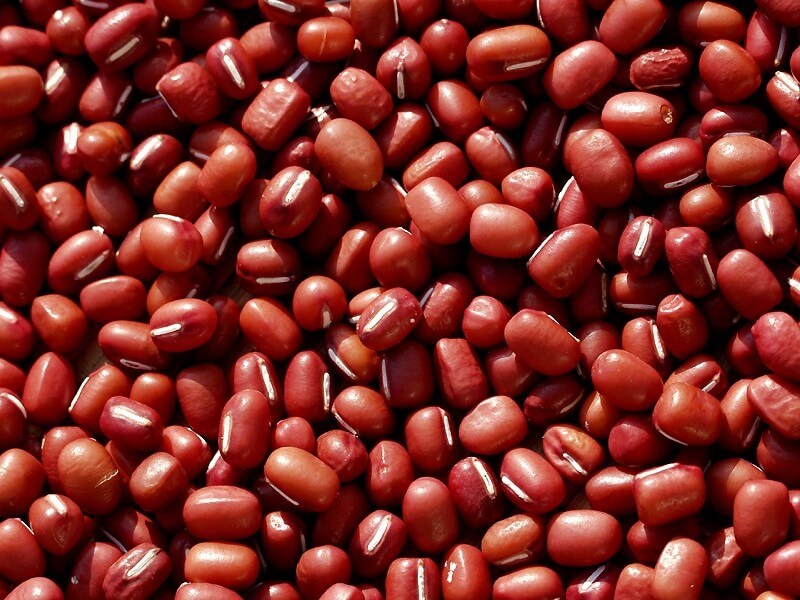While not as common as kidney beans, adzuki beans are another healthy bean that you can add to your diet for some more variety.
I’ve compared these beans head to head below when it comes to taste and nutrition.
Table of Contents
Taste of Adzuki Beans vs Kidney Beans
While these beans do have distinct tastes, they’re fairly similar to each other compared to other beans:
- Adzuki beans – These are typically small red beans, although they do come in other color varieties. They are about half the size of kidney beans, and traditionally used in Chinese and Japanese dishes (both main course recipes and desserts). You’ll also find them in recipes for soups, stews, and vegetarian curries. Adzuki beans have a slightly sweet taste.
- Kidney beans – Kidney beans are the most popular red bean in most countries, although white kidney beans are also fairly easy to find. They are great in hearty meals like chili, as kidney beans add an earthy texture. Kidney beans have a fairly plain taste, but soak up flavors well from other ingredients.
Can I Use Adzuki Beans Instead of Kidney Beans

You can use kidney beans or adzuki beans in place of each other in any main dish in a one to one ratio.
The exceptions are if you’re making desserts, which usually specify adzuki beans for a reason. If you use kidney beans instead, the result won’t be great.
Nutritional Value Comparison
Since kidney beans and adzuki beans share a lot in common, it’s not surprising that their nutrition content is extremely similar.
Here’s a quick side-by-side comparison.
Macros
Let’s start by looking at the macronutrients in each type of bean per 100 grams.
| Adzuki Beans | Kidney Beans | |
|---|---|---|
| Energy (kcal) | 127.8 | 127.1 |
| Protein (g) | 7.5 | 8.7 |
| Total Lipid (g) | 0.1 | 0.5 |
| Carbohydrate (g) | 24.8 | 22.8 |
| Fiber (g) | 7.3 | 7.4 |
| Sugars (g) | 0.0 | 0.3 |
They basically have the exact same amount of calories, protein, fat, and carbohydrates.
Vitamins and Minerals
While this data will vary by brand and test sample, here is data from the USDA showing the vitamins and minerals in both adzuki and kidney beans.
I’ve also included the RDA for each nutrient for adults. Use this for a reference if you’re wondering how much of the daily value you get in 100 grams of cooked beans.
| RDA | Adzuki Beans | Kidney Beans | |
|---|---|---|---|
| Calcium (mg) | 1200 | 27.8 | 28.2 |
| Iron (mg) | 18 | 2.0 | 2.9 |
| Magnesium (mg) | 400 | 52.2 | 45.2 |
| Phosphorus (mg) | 700 | 167.8 | 141.8 |
| Potassium (mg) | – | 532.2 | 402.8 |
| Zinc (mg) | 11 | 1.8 | 1.1 |
| Manganese (mg) | 2.3 | 0.6 | 0.5 |
| Thiamin (mg) | 1.2 | 0.1 | 0.2 |
| Vitamin B-6 (mg) | 1.3 | 0.1 | 0.1 |
| Folate (µg) | 400 | 120.9 | 129.9 |
I omitted the nutrients that aren’t found in substantial amounts in these beans.
Not surprisingly, both beans have a very similar profile. Both are good sources of:
- Calcium
- Iron
- Zinc
- Folate
What Are the Differences Between Adzuki Beans and Kidney Beans?
As we’ve seen, there’s very little difference between the nutritional value of adzuki beans and kidney beans.
The biggest differences are:
- Kidney beans are twice as big
- Adzuki beans have more of a sweet taste
- In general, kidney beans are best for hearty meals, while adzuki beans are best for light and sweeter meals.
For the most part, you can substitute one bean for another, except in desserts that specifically use adzuki beans.
